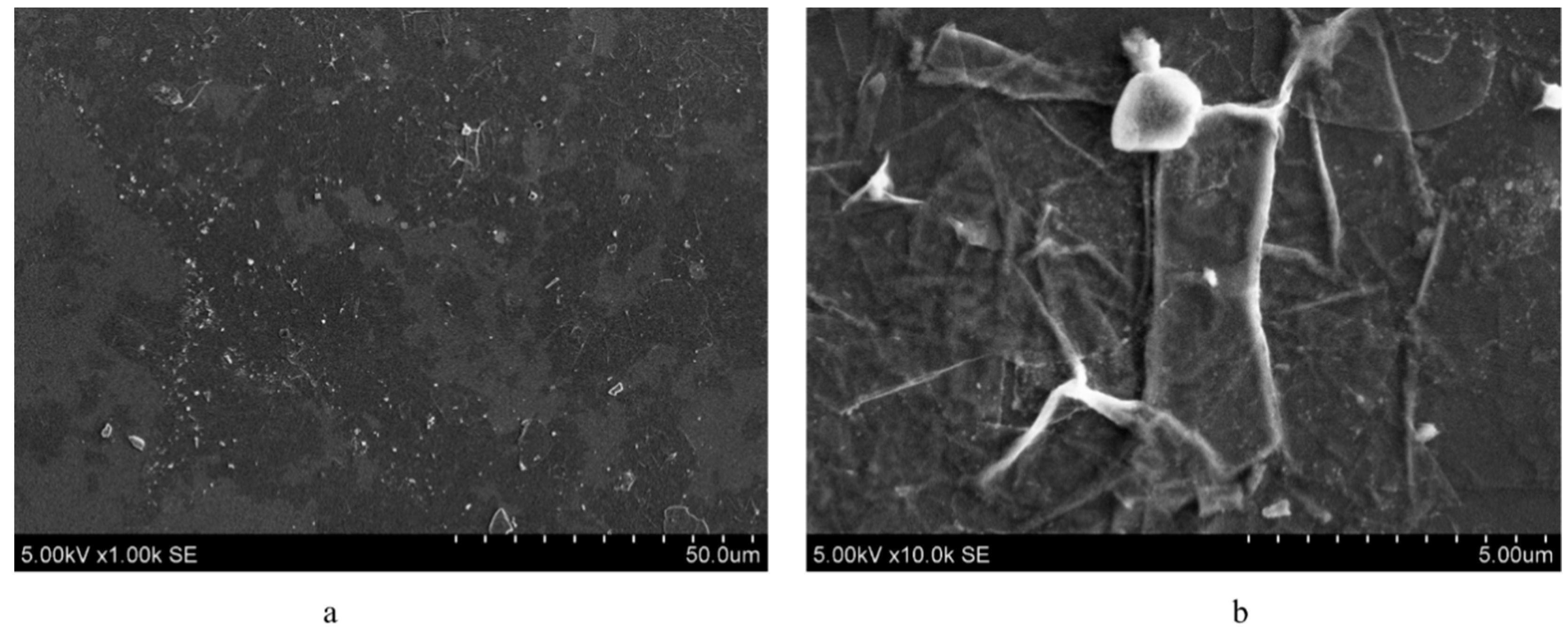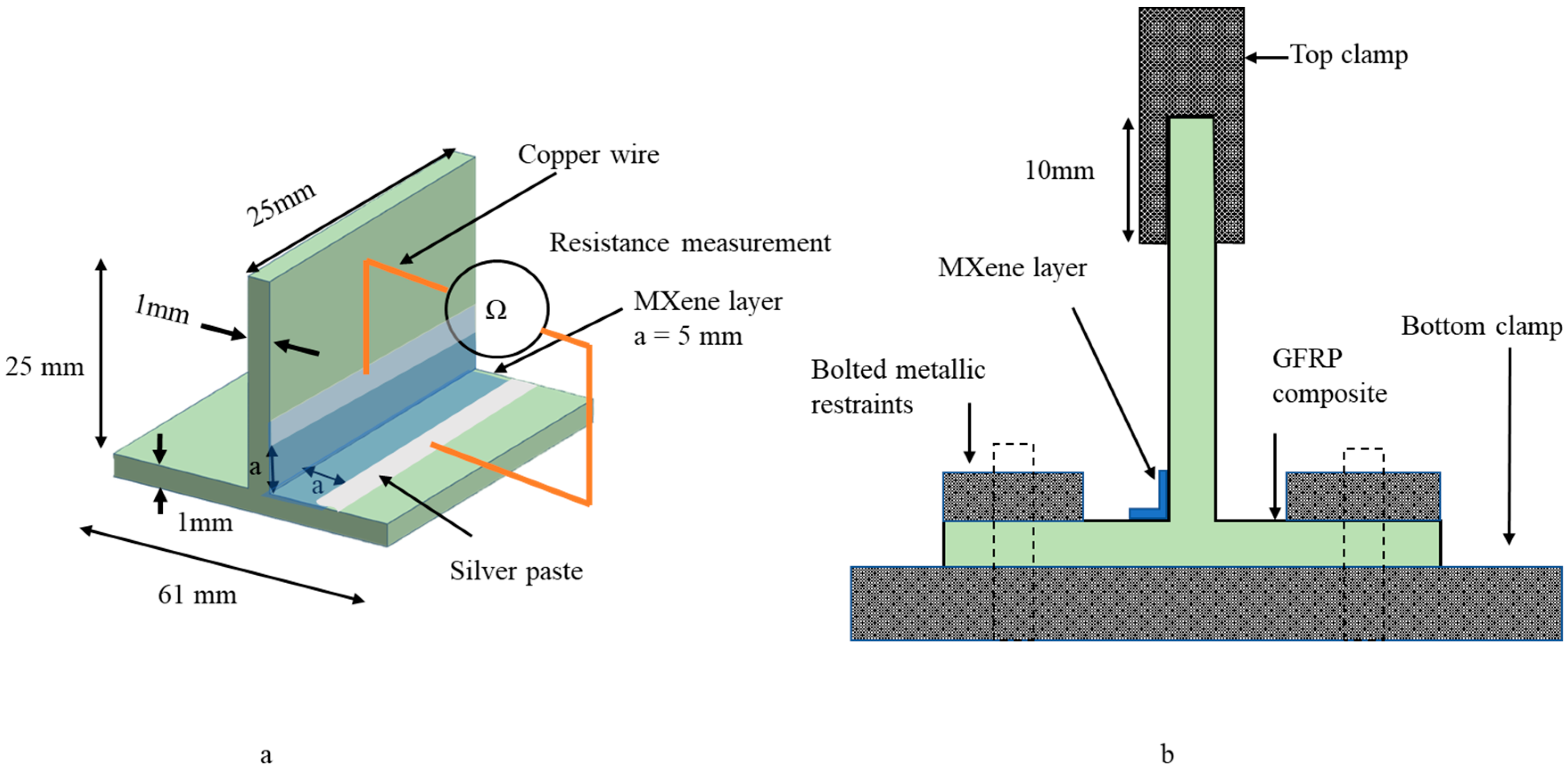In Situ Deformation Monitoring of 3D Woven Composite T-Profile Using MXene Nanoparticles
Abstract
:1. Introduction
2. Materials and Methods
2.1. Preparation of MXenes
2.2. Weaving of T-Profile Preform and Composite Manufacturing
2.3. Tensile Testing
2.4. Fatigue Testing
3. Results and Discussion
3.1. Tensile Testing Results and Dicussion
3.2. Fatigue Testing Results and Discussion
4. Conclusions
- The concept of spraying MXene particles on the junction of the composite T-profile is efficient for real-time damage and deformation sensing of complex-shaped composites under tensile and fatigue loading. The partially delaminated MXene flakes of 3.3 mg/mL concentration were successful in sensing the deformation of the T-profile composite.
- During tensile testing of the samples, the main failure zone observed was the junction region, indicating its critical nature and the need for health monitoring. The MXene coating sprayed at the junction was able to sense the initial failure at 2.44 mm displacement as a spike in the resistance values, as well as the total deformation till failure as a steady increase in the resistance values.
- Damage during the fatigue loading was sensed as an abrupt change in the resistance value for same loading conditions. During fatigue loading at 50 N and 100 N, the MXene coating was stable and captured the cyclic stress at 0.5 Hz and 1 Hz, respectively. At a 50 N–0.5 Hz load-frequency combination, there was no damage to the MXene coating and, thus, the resistance values remained stable. However, at a 100 N–1 Hz load–frequency, there was a permanent increase of 3.2% in the resistance of the MXene coating, which indicates a threshold level of damage initiation.
- The smart composites in this study are easy to manufacture and cost-efficient; however, the sensing function is only limited for deformation monitoring. In the future scope of work, the piezoresistive response of the MXene nanoparticles can be calibrated against conventional strain gauges mounted on the base and the flange sections of the T-profile. The data thus obtained can be processed to determine stress at various zones in the complex-shaped composites.
- The concept of this research work can be applied to monitor large complex-shaped components that are expensive and require monitoring at critical junctions. The dimensional tolerances of such components are strict and, thus, the incorporation of traditional strain gauges and external sensor elements is difficult. In such scenarios, the conductive coating of MXene nanoparticles in a small area can be an effective solution.
Author Contributions
Funding
Institutional Review Board Statement
Informed Consent Statement
Data Availability Statement
Conflicts of Interest
References
- Jolly, M.R.; Prabhakar, A.; Sturzu, B.; Hollstein, K.; Singh, R.; Thomas, S.; Foote, P.; Shaw, A. Review of Non-destructive Testing (NDT) Techniques and their Applicability to Thick Walled Composites. Procedia CIRP 2015, 38, 129–136. [Google Scholar] [CrossRef] [Green Version]
- Dwivedi, S.K.; Vishwakarma, M.; Soni, A. Advances and Researches on Non Destructive Testing: A Review. Mater. Today Proc. 2018, 5, 3690–3698. [Google Scholar] [CrossRef]
- Ciampa, F.; Mahmoodi, P.; Pinto, F.; Meo, M. Recent Advances in Active Infrared Thermography for Non-Destructive Testing of Aerospace Components. Sensors 2018, 18, 609. [Google Scholar] [CrossRef] [Green Version]
- Crivelli, D.; Guagliano, M.; Eaton, M.; Pearson, M.; Al-Jumaili, S.; Holford, K.; Pullin, R. Localisation and identification of fatigue matrix cracking and delamination in a carbon fibre panel by acoustic emission. Compos. Part B Eng. 2015, 74, 1–12. [Google Scholar] [CrossRef] [Green Version]
- Gholizadeh, S. A review of non-destructive testing methods of composite materials. Procedia Struct. Integr. 2016, 1, 50–57. [Google Scholar] [CrossRef] [Green Version]
- Giurgiutiu, V. Structural health monitoring (SHM) of aerospace composites. In Polymer Composites in the Aerospace Industry; Elsevier: Amsterdam, The Netherlands, 2015; pp. 449–507. [Google Scholar]
- Hisada, S.; Minakuchi, S.; Takeda, N. In-Situ Strain Monitoring in Deltoid of Composite T-joints using Optical Fiber. Struct. Health Monit. 2021, 18, 161–169. [Google Scholar] [CrossRef]
- Nauman, S.; Cristian, I.; Koncar, V. Intelligent carbon fibre composite based on 3D-interlock woven reinforcement. Text. Res. J. 2012, 82, 931–944. [Google Scholar] [CrossRef]
- Ning, F.; He, G.; Sheng, C.; He, H.; Wang, J.; Zhou, R.; Ning, X. Yarn on yarn abrasion performance of high modulus polyethylene fiber improved by graphene/polyurethane composites coating. J. Eng. Fibers Fabr. 2021, 16, 155892502098356. [Google Scholar] [CrossRef]
- Monastyreckis, G.; Stepura, A.; Soyka, Y.; Maltanava, H.; Poznyak, S.; Omastová, M.; Aniskevich, A.; Zeleniakiene, D. Strain Sensing Coatings for Large Composite Structures Based on 2D MXene Nanoparticles. Sensors 2021, 21, 2378. [Google Scholar] [CrossRef]
- Shimpi, P.; Aniskevich, A.; Zeleniakiene, D. Improved method of manufacturing carbon nanotube infused multifunctional 3D woven composites. J. Compos. Mater. 2021, 56, 479–489. [Google Scholar] [CrossRef]
- Stankevich, S.; Bulderberga, O.; Tarasovs, S.; Zeleniakiene, D.; Omastova, M.; Aniskevich, A. Electrical Conductivity of Glass Fiber-Reinforced Plastic with Nanomodified Matrix for Damage Diagnostic. Materials 2021, 14, 4485. [Google Scholar] [CrossRef] [PubMed]
- Tang, L.-C.; Wan, Y.-J.; Yan, D.; Pei, Y.-B.; Zhao, L.; Li, Y.-B.; Wu, L.-B.; Jiang, J.-X.; Lai, G.-Q. The effect of graphene dispersion on the mechanical properties of graphene/epoxy composites. Carbon 2013, 60, 16–27. [Google Scholar] [CrossRef]
- Forcellese, A.; Simoncini, M.; Vita, A.; Giovannelli, A.; Leonardi, L. Performance analysis of MWCNT/Epoxy composites produced by CRTM. J. Mater. Process. Technol. 2020, 286, 116839. [Google Scholar] [CrossRef]
- Khan, T.A.; Nauman, S.; Asfar, Z.; Nasir, M.A.; Khan, Z. Screen-printed nanocomposite sensors for online in situ structural health monitoring. J. Thermoplast. Compos. Mater. 2018, 33, 236–253. [Google Scholar] [CrossRef]
- Turgut, F.; Koycu, A.; Neje, G.; Behera, B.; Yenigun, E.O.; Cebeci, H. Hierarchical CNTs Grown Multifunctional 3D Woven Composite Beams for Aerospace Applications. In Proceedings of the AIAA Scitech 2020 Forum, Orlando, FL, USA, 6–10 January 2020. [Google Scholar] [CrossRef] [Green Version]
- Handschuh-Wang, S.; Wang, T.; Tang, Y. Ultrathin Diamond Nanofilms—Development, Challenges, and Applications. Small 2021, 17, 2007529. [Google Scholar] [CrossRef]
- Xiao, C.; Zhao, Y.; Zhou, W. Nanoimprinted conducting nanopillar arrays made of MWCNT/polymer nanocomposites: A study by electrochemical impedance spectroscopy. Nanoscale Adv. 2020, 3, 556–566. [Google Scholar] [CrossRef]
- Gong, K.; Zhou, K.; Qian, X.; Shi, C.; Yu, B. MXene as emerging nanofillers for high-performance polymer composites: A review. Compos. Part B Eng. 2021, 217, 108867. [Google Scholar] [CrossRef]
- Zhu, H.; Zhu, J.; Zhang, Z.; Zhao, R. Crossover from Linear Chains to a Honeycomb Network for the Nucleation of Hexagonal Boron Nitride Grown on the Ni(111) Surface. J. Phys. Chem. C 2021, 125, 26542–26551. [Google Scholar] [CrossRef]
- Zhang, J.; Kong, N.; Uzun, S.; Levitt, A.; Seyedin, S.; Lynch, P.A.; Qin, S.; Han, M.; Yang, W.; Liu, J.; et al. Scalable Manufacturing of Free-Standing, Strong Ti 3 C 2 T x MXene Films with Outstanding Conductivity. Adv. Mater. 2020, 32, e2001093. [Google Scholar] [CrossRef]
- Plummer, G.; Anasori, B.; Gogotsi, Y.; Tucker, G.J. Nanoindentation of monolayer Ti C T MXenes via atomistic simulations: The role of composition and defects on strength. Comput. Mater. Sci. 2018, 157, 168–174. [Google Scholar] [CrossRef]
- Ng, V.M.H.; Huang, H.; Zhou, K.; Lee, P.S.; Que, W.; Xu, J.Z.; Kong, L.B. Recent progress in layered transition metal carbides and/or nitrides (MXenes) and their composites: Synthesis and applications. J. Mater. Chem. A 2016, 5, 3039–3068. [Google Scholar] [CrossRef]
- Liu, J.; Tang, J.; Gooding, J.J. Strategies for chemical modification of graphene and applications of chemically modified graphene. J. Mater. Chem. 2012, 22, 12435–12452. [Google Scholar] [CrossRef]
- Zukiene, K.; Monastyreckis, G.; Kilikevicius, S.; Procházka, M.; Micusik, M.; Omastová, M.; Aniskevich, A.; Zeleniakiene, D. Wettability of MXene and its interfacial adhesion with epoxy resin. Mater. Chem. Phys. 2020, 257, 123820. [Google Scholar] [CrossRef]
- Shi, Y.; Liu, C.; Liu, L.; Fu, L.; Yu, B.; Lv, Y.; Yang, F.; Song, P. Strengthening, toughing and thermally stable ultra-thin MXene nanosheets/polypropylene nanocomposites via nanoconfinement. Chem. Eng. J. 2019, 378, 122267. [Google Scholar] [CrossRef]
- Gao, L.; Li, C.; Huang, W.; Mei, S.; Lin, H.; Ou, Q.; Zhang, Y.; Guo, J.; Zhang, F.; Xu, S.; et al. MXene/Polymer Membranes: Synthesis, Properties, and Emerging Applications. Chem. Mater. 2020, 32, 1703–1747. [Google Scholar] [CrossRef]
- Hai, Y.; Jiang, S.; Zhou, C.; Sun, P.; Huang, Y.; Niu, S. Fire-safe unsaturated polyester resin nanocomposites based on MAX and MXene: A comparative investigation of their properties and mechanism of fire retardancy. Dalton Trans. 2020, 49, 5803–5814. [Google Scholar] [CrossRef]
- Wang, X.; Lu, J.; Lu, S.; Li, B.; Zhang, L.; Ma, C.; Ma, K.; Lin, L.; Jiang, X.; Yang, B. Health monitoring of repaired composite structure using MXene sensor. Compos. Commun. 2021, 27, 100850. [Google Scholar] [CrossRef]
- Stickler, P.B.; Ramulu, M. Experimental study of composite T-joints under tensile and shear loading. Adv. Compos. Mater. 2006, 15, 193–210. [Google Scholar] [CrossRef]
- Bai, J.-B.; Dong, C.; Xiong, J.-J.; Luo, C.-Y.; Chen, D. Progressive damage behaviour of RTM-made composite T-joint under tensile loading. Compos. Part B Eng. 2018, 160, 488–497. [Google Scholar] [CrossRef]
- Yan, S.; Zeng, X.; Long, A. Experimental assessment of the mechanical behaviour of 3D woven composite T-joints. Compos. Part B Eng. 2018, 154, 108–113. [Google Scholar] [CrossRef] [Green Version]
- Bigaud, J.; Aboura, Z.; Martins, A.; Verger, S. Analysis of the mechanical behavior of composite T-joints reinforced by one side stitching. Compos. Struct. 2018, 184, 249–255. [Google Scholar] [CrossRef]
- Sugun, B.; Shimpi, P. Orthogonal weaving. In Practical Approach to 3D Weaving; Sugun, B.S., Ed.; Springer International Publishing: Cham, Switzerland, 2021; pp. 1–28. [Google Scholar] [CrossRef]
- Sugun, B.; Sandeep, D. Development of single-layer 3D ‘T’ profile with fillet for composite ‘T’ joints. J. Ind. Text. 2016, 46, 887–900. [Google Scholar] [CrossRef]
- Wang, Y.; Soutis, C. Fatigue Behaviour of Composite T-Joints in Wind Turbine Blade Applications. Appl. Compos. Mater. 2016, 24, 461–475. [Google Scholar] [CrossRef]
- Ooijevaar, T.; Loendersloot, R.; Warnet, L.; de Boer, A.; Akkerman, R. Vibration based Structural Health Monitoring of a composite T-beam. Compos. Struct. 2010, 92, 2007–2015. [Google Scholar] [CrossRef]
- Panda, S.; Mishra, P. Damage Propagation Prediction of Adhesion Failure in Composite T-joint Structure and Improvement using PZT Patch. Sci. Iran. 2021, 28, 3232–3245. [Google Scholar] [CrossRef]
- Wan, Y.; Hu, W.; Yang, B.; Zhao, X.; Xian, G.; Yuan, Y.; He, L.; Liu, C.; Deng, J. On-line tensile damage monitoring of WGF/epoxy T-joint by the embedded MWCNT@WGF sensor. Compos. Commun. 2020, 23, 100541. [Google Scholar] [CrossRef]
- Verma, K.K.; Sandeep, D.N.; Sugun, B.S.; Athimoolaganesh, S. Novel Design of Cocured Composite ‘T’ Joints with Integrally Woven 3D Inserts. In Proceedings of the 5th World Conference on 3D Fabrics and Their Applications, Delhi, India, 16–17 December 2013; pp. 16–17. [Google Scholar]
- Yan, S.; Zeng, X.; Brown, L.; Long, A. Geometric modeling of 3D woven preforms in composite T-joints. Text. Res. J. 2017, 88, 1862–1875. [Google Scholar] [CrossRef] [Green Version]





| Parameter | Values | |
|---|---|---|
| No. of cycles | 2000 | 4000 |
| Frequency (Hz) | 0.5 | 1 |
| Load (N) | 50 | 100 |
| Parameter | Sample 1 | Sample 2 | Sample 3 | Sample 4 |
|---|---|---|---|---|
| Correlation coefficient | 0.70 | 0.68 | 0.71 | 0.68 |
| Ultimate tensile force (N) | 1150 | 2138.5 | 2140.2 | 1918.4 |
Publisher’s Note: MDPI stays neutral with regard to jurisdictional claims in published maps and institutional affiliations. |
© 2022 by the authors. Licensee MDPI, Basel, Switzerland. This article is an open access article distributed under the terms and conditions of the Creative Commons Attribution (CC BY) license (https://creativecommons.org/licenses/by/4.0/).
Share and Cite
Shimpi, P.; Omastova, M.; Aniskevich, A.; Zeleniakiene, D. In Situ Deformation Monitoring of 3D Woven Composite T-Profile Using MXene Nanoparticles. Materials 2022, 15, 2730. https://doi.org/10.3390/ma15082730
Shimpi P, Omastova M, Aniskevich A, Zeleniakiene D. In Situ Deformation Monitoring of 3D Woven Composite T-Profile Using MXene Nanoparticles. Materials. 2022; 15(8):2730. https://doi.org/10.3390/ma15082730
Chicago/Turabian StyleShimpi, Prasad, Maria Omastova, Andrey Aniskevich, and Daiva Zeleniakiene. 2022. "In Situ Deformation Monitoring of 3D Woven Composite T-Profile Using MXene Nanoparticles" Materials 15, no. 8: 2730. https://doi.org/10.3390/ma15082730
APA StyleShimpi, P., Omastova, M., Aniskevich, A., & Zeleniakiene, D. (2022). In Situ Deformation Monitoring of 3D Woven Composite T-Profile Using MXene Nanoparticles. Materials, 15(8), 2730. https://doi.org/10.3390/ma15082730









